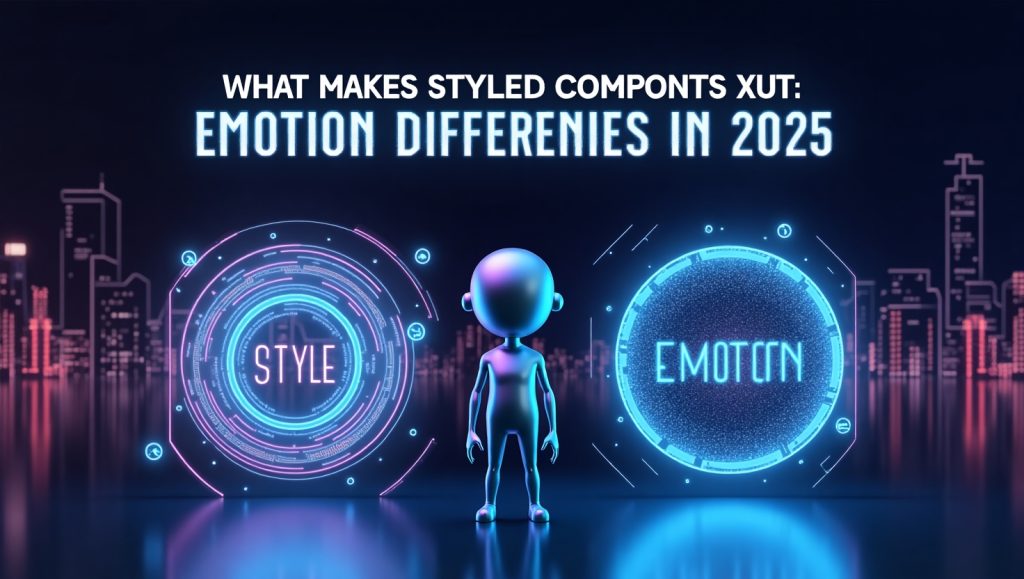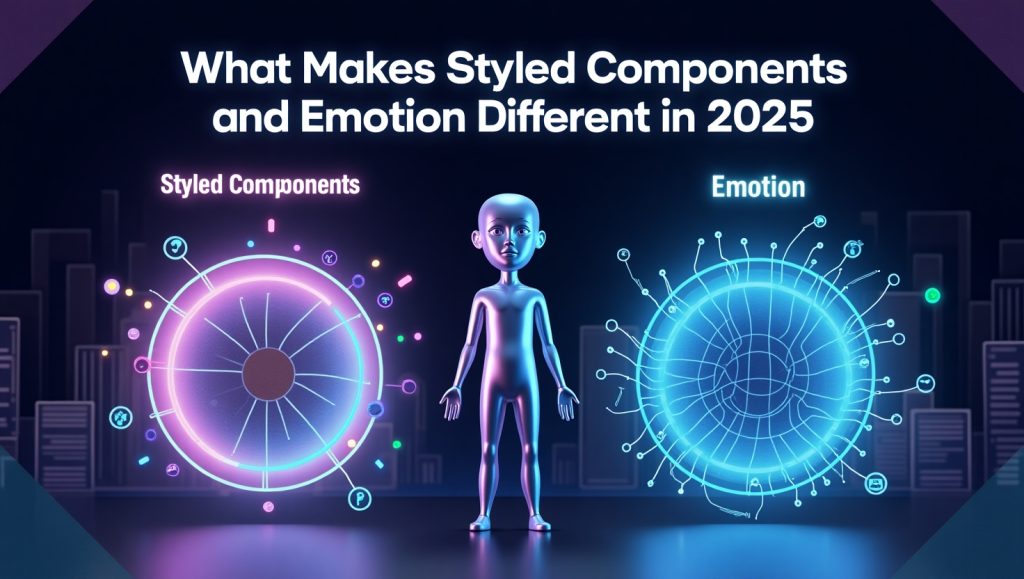
Styled Components vs Emotion a 2025 Perspective
As we enter the year 2025, frontend developers have their hands full with up-to-date styling tools. Styled Components and Emotion keep making headlines in the React ecosystem. With these libraries, developers can write CSS in JavaScript to enhance their modularity and maintainability. However, beneath their apparent similarities, the subtleties of performance and use cases vary widely for both.
Styled Components claim allegiance to the creators of the styled-components GitHub repo to make developers think of CSS in a whole new way. The tagged template literals provide the mechanism to style the components and are fundamentally all about the developer experience. Conversely, Emotion provides more flexibility, allowing it to work in either a styled-components-like syntax or a more functional object-based style.
The performance concerns, customization options, adoption by different communities, and degrees of compatibility with various frameworks form a spectrum of differences between these two even in their usages. The other considerations would include rendering speeds, theme integration, SSR (server-side rendering) performance, and long-term achieve scalability of the styling tools. The flexibility and TypeScript integration of Emotion is gaining much applause from the developers, but the elegant API of Styled Components, along with the well-structured documentation, still win a lot of hearts.
The choice between the two is not that easy-it depends on the project needs. Are you dealing with a huge design system, or are you just doing a quick MVP? Which angle are you approaching from? Developer productivity or runtime? These
Performance and Rendering Efficiency
Server-Side Rendering and Caching
With the rise of edge computing and static-site generation, server-side rendering (SSR) has gained even more importance. Emotion has taken the lead slightly when it comes to SSR. Its extraction methods can serve critical CSS faster and achieve better initial load times. Styled Components can also work with SSR, but many developers feel it is just that little bit more difficult to use and slower than Emotion.
Emotion comes caching by default, which prevents running style computations unnecessarily. This can save very important milliseconds in rendering time, especially for apps with lots of component reuse.
Styled Components have matured from earlier versions and significantly improved SSR support attempted, where even this heaviness was designed to push template literals into runtime processing. In such a scenario, Emotion might very well take home most of the trophies for teams for whom fast initial paint is a priority.
Syntax and Developer Flexibility

The way developers write code matters. Readable, clean syntax can make or break productivity in the long run.
Styled API vs. Object Styles
Styled Components is all about the styled API—using template literals to write your CSS inline. For example:
const Button = styled.button`
background-color: blue;
color: white;
`;
This syntax is very readable for those with a CSS background and keeps styling close to the component.
Emotion, however, gives you both options: you can write styled components in a similar way or use object styles, which look like this:
const style = {
backgroundColor: ‘blue’,
color: ‘white’
};
It’s a great win for the developers, who prefer JavaScript to CSS; this flexibility of Emotion. It’s dynamic; you can conditionally apply styles based on props or logic without having to use an interpolated template string. Styled Components is much more opinionated. It favours a much more CSS type of experience, which can be great for keeping things consistent, but somewhat limiting to some developers. In contrast, Emotion tends to be leaning more toward flexibility; thus, may cater more to those advanced users or to those who are developing custom UI systems.
Theming and Design Systems
Design systems are the backbone of scalable frontend work in 2025, and theming plays a big role in that. Both libraries offer theming support, but they go about it differently.
Context and Theme Management
Styled Components incorporates a ThemeProvider which wraps your application and relays the theme object further down in context. Thereafter, it encodes theme values into styled components, making their inclusion easy in terms of props. Emotion consistently provides an equivalent but well-integrated system for TypeScript users. A similar theme system makes it a better tool for a hybrid codebase or for transitioning teams because it connects with other styling solutions. By the years 2025, there are more large teams seething with demands to build applications that can run on different platforms, and Emotion’s theme capabilities extend even further by seamlessly integrating into frameworks such as Next.js and React Native.
Styled Components is catching up, but some developers have shared experiences of having to deal with a lot of resistance in more complex use cases of theming-most especially as dynamic or responsive as viewed through different devices. Emotion provides ample room for scale without reaching a crunch in constrained environments for the large UI libraries which are heavy on themes.
Tooling, TypeScript, and Ecosystem Support
Modern JavaScript development relies heavily on tools and typing. Here’s how Styled Components and Emotion stack up in that department in 2025.
TypeScript Support and Dev Tools
Another area where Emotion certainly triumphs over TypeScript is in the ease with which it can be typed, coming with much more out-of-the-box intelligent typing. Instead, using Styled Components requires developers to do a lot of boilerplate typing to have good proper typing for themes and styled components.
That said, Styled Components have improved significantly regarding their TypeScript support in the past few years. Updating it makes the typing for themes less of a hassle than before, but it leaves Emotion feeling faster in the environment of the developer.
For the rest, they now provide corresponding browser extensions that will help you inspect and debug all those styled components as you build your projects. Emotion’s tooling, however, integrates better with some of those modern frameworks, like Remix and Astro, while Styled Components might require a bit of configuration.
If giving very rigid and reliable TypeScript typing and fast iteration for developers is your need, then Emotion is what you should settle for. For all the traditional setups or teams who still enjoyed CSS, Styled Components is worth it.
Community, Learning Curve, and Adoption
No tool thrives without a strong community—and both Styled Components and Emotion enjoy loyal followings. But things are shifting in 2025.
Documentation and Community Adoption
It’s no surprise that Styled Components prevailed for so long, for the number of its associated literature, blog entries, and tutorials on YouTube is almost daunting. This amounts to an easy start for a beginner, especially someone who already speaks the CSS lingo.
Having come in later in the game, Emotion now seems to have caught up, thanks to a massive presence in modern React tooling and concerted efforts by performance and scalability-focused companies: currently, it is the default styling solution in some modern UI libraries, which further propels its adoption.
As far as community support is concerned, both packages maintain active GitHub repos and constant maintenance in addition to an ever-strong Discord or Slack community presence. But recently, because of contributions from devs with a focus on performance and a wider flexibility, Emotion is emerging as a preferred choice in a few enterprise scenarios.
As for stability and easy onboarding, Styled Components would still be an obvious choice. Emotion, on the other hand, would be better suited for the performance-conscious and very flexible.
Conclusion
Making a decision between Styled Components and Emotion in 2025 is basically about your project’s needs and the way your team operates. Styled Components is great for those in love with the clean CSS-like syntax, delivering strong default settings. Emotion suits a more dynamic, TypeScript-driven stack where flexibility is needed.
Both libraries are mature and robust. Which one you choose is in the eye of the beholder. However, having a grasp of the differences between them may well be the critical defense for the stack you are looking to use.
Performance, developer experience, or cross-platform design systems indicate which styling tool you can use. And as web development continues to evolve, these libraries would always have to adapt and evolve as well to meet our ever-changing needs.